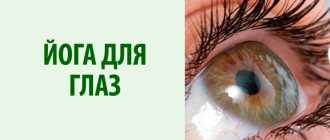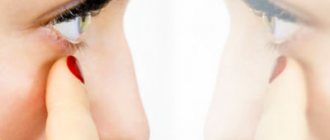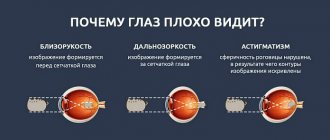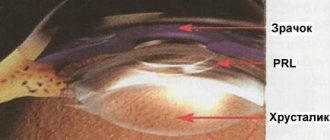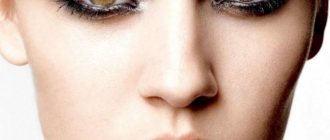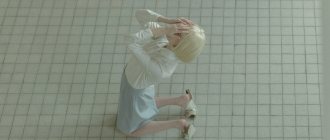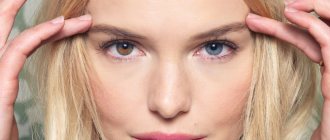November 16, 2012
Excessive eye strain leads to headaches and decreased vision. How to avoid fatigue and protect your eyes?
Visual discomfort caused by eye strain is called asthenopia. This is a very common problem among those who constantly work on a computer, watch a lot of TV and drive a car. Excessive eye strain leads to temporary decreased vision, watery eyes and headaches. In the long term, it can cause the development of visual impairments, such as myopia
.
Gymnastics for the eyes
Are your eyes tired from working at the computer every day? Perform eye exercises daily to get rid of fatigue and avoid decreased vision.
Causes
The most common cause of eye strain is working at a short distance from the eyes to the object. Most often, people who work with computers, books, papers and small parts encounter this problem. The following factors can also provoke the development of visual fatigue:
- regular driving of motor vehicles;
- wearing inappropriate glasses or contacts;
- long periods of watching TV;
- working in poor lighting.
Depending on the etiological factor, the following types of asthenopia are distinguished:
- Muscular. The tension occurs due to congenital weakness of the intrinsic muscles that allow eye movement. In this case, there is excessive convergence. If you close one eye, the tension immediately goes away. Muscle fatigue can also be a consequence of uncorrected myopia, accompanied by impaired three-dimensional vision and hidden strabismus.
- Accommodative . The most common form of the disease, in which there is severe tension in the ciliary muscle (the muscle that regulates the shape of the lens). This disorder can be observed in the following pathological conditions: spasm of accommodation, farsightedness, astigmatism, presbyopia, intoxication of the body.
- Neurogenic. This form of pathology develops against the background of nervous disorders: neurosis, hysteria. Treatment in this case is carried out by a neurologist or psychiatrist.
- Symptomatic. Eye strain is a manifestation of another disease of the organs of vision, hearing or smell.
Sometimes tension in the eye muscles occurs due to general diseases, fatigue or intoxication of the body. In this case, asthenic asthenopia is diagnosed, the therapy of which is primarily aimed at eliminating the root cause.
Classification
The classification of the disease depends on the processes occurring inside the organs of vision and the reasons that caused it.
- Accommodative. The condition appears for several reasons: decreased muscle tone around the eyes, impaired transmission of light through the pupil and lens, clouding of the lens. The light beam passing through the pupil of the retina is projected incorrectly. Increased eye strain occurs.
- Muscular. Disturbance in the activity of the oculomotor system. As a result, myopia develops, visual function is gradually lost, and strabismus may develop.
- Mixed. This is a combination of the two previous forms, creating a double load on the eyes. Therefore, a person cannot concentrate on any subject. The surrounding space is seen in a blurred form.
- Neurogenic. It is formed as a result of disruption of the nerve receptors on the retina of the eyes or the visual center in the brain. The cause may be mechanical damage, compression by neighboring structures, or the development of malignant and benign neoplasms.
- Symptomatic. Appears as a result of primary diseases that lead to increased eye fatigue. These can be various inflammatory processes, glaucoma, cataracts, retinal detachment, optic nerve atrophy and other diseases.
It is important for a doctor to classify the disease, since further treatment will depend on it. If you don't remove the root cause, your eyes will be constantly tired. Pain, photophobia and other negative signs will appear. Visual acuity will gradually deteriorate until complete blindness.
Symptoms
Eye muscle tension can manifest itself in a variety of symptoms. The most common manifestations of the disease are:
- sensation of a foreign body in the eyes;
- diplopia;
- blurred vision;
- periodic appearance of light glare;
- stinging, pain in the eyes;
- tearfulness;
- blurry image;
- rapid fatigue;
- headache;
- feeling of pressure in the forehead, temples.
Sometimes there is a distortion of the shape or size of visible objects, increased sensitivity to light, and hyperemia of the eyeballs. A person faced with eye strain becomes nervous and irritable. With asthenopia, one, several or even all of the above symptoms of visual fatigue may appear. Manifestations of pathology are always observed after visual stress (working at a computer, reading, sewing).
Sometimes asthenopia is complemented by blepharitis, conjunctivitis and other inflammatory eye diseases.
Complications
If the patient is left untreated, complications may result. When they are detected, the doctor decides whether they can be corrected or whether the changes are irreversible. The following types of complications are distinguished:
- a gradual decrease in visual acuity up to complete blurring before the eyes, complete loss of function is possible;
- impaired color perception due to damage to nerve receptors, the lens, the cornea, if left untreated the defect may be irreversible;
- death of part of an organ due to malnutrition through the blood;
- strabismus, which manifests itself as a result of disruption of the oculomotor system;
- increased intraocular pressure leading to glaucoma.
Diagnostic methods
To identify the problem, the doctor first interviews the patient, collects a detailed history, then performs an ophthalmoscopy and prescribes the following diagnostic measures:
- Visometry. Allows you to determine the degree of change in visual acuity. Myopia is often found in patients with eye strain.
- Refractometry. Necessary for detecting refractive changes in the early stages; it allows identifying myopia and astigmatism.
- Biomicroscopy. Allows you to study the anterior part of the eyeball and diagnose conjunctivitis.
- Accommodation Research . Accommodative ability is studied and proximetry is performed. If there is visual fatigue, a person is diagnosed with a shift in the point of clear vision towards myopia.
If a patient has tension in the eye muscles, a comprehensive treatment is selected for him, consisting of optical correction, drug therapy, visual gymnastics and folk remedies.
If such a problem is discovered, the patient should be regularly checked by an ophthalmologist, undergo ophthalmoscopy and ocular tonometry.
At-risk groups
There are different groups of patients who are most susceptible to visual fatigue. These include:
- people suffering from myopia and farsightedness;
- patients who work at a computer for a long time;
- persons working in workplaces with hazardous chemicals or in low light conditions;
- children who spend a lot of time at school or at home studying, as a result of which the undeveloped organ of vision becomes overstrained.
These categories of patients should be periodically examined by an ophthalmologist in order to promptly identify emerging abnormalities. The earlier the disorder is diagnosed, the more effective treatment procedures will be.
Effective eye drops for eyestrain
When a problem such as eye strain occurs, one of the best treatment methods is instillation of ophthalmic drops. The following medications will help relieve fatigue and discomfort in the eyes when working at a computer for long periods of time:
- Visine. Effective eye drops for eye redness with a natural composition, which helps to constrict the eye blood vessels, eliminate irritation and itching in just a couple of minutes. Suitable for eliminating minor fatigue.
- Inoxa. Helps moisturize the eyeball, eliminate redness and relax the eye muscles. The drug is effective and completely safe.
- Taufon. Promotes tissue regeneration, relieves inflammation, cools and constricts blood vessels. Suitable for long-term use.
- Korneregel. Relieves fatigue after prolonged work at the computer, eliminates dryness and irritation, promotes tissue regeneration, and eliminates inflammation.
- Oksial. Quickly eliminates dryness and fatigue of the eyes, promotes the formation of a film that protects the eyeball from drying out due to slow blinking.
Read in a separate article: Blepharospasm: what it is, causes, symptoms and treatment
Before choosing suitable drops for eye strain, it is recommended to undergo an examination and consult with a doctor. If visual fatigue is minor, you can consult a pharmacist.
Before using the drug, you should study the instructions in detail and do not forget about the rules of personal hygiene.
Prevention
This unpleasant phenomenon can be prevented by using preventive measures. They are aimed at preventing the primary process or the development of relapse of the disease:
- Periodic examination by an ophthalmologist. Carrying out diagnostic and laboratory activities.
- Timely treatment of all primary diseases. Use of adequate dosage of prescribed medications. No independent replacement of medications.
- Reducing hours spent in front of the computer, TV, telephone.
- Walking in the fresh air in unlimited space. The organs of vision relax when there is no need to concentrate on close objects.
- Proper nutrition, including all the vitamins and nutrients necessary for the normal functioning of the visual organs.
- Work and read books in a well-lit space.
- Protect your eyes from bright light with sunglasses.
- During prolonged work, periodically perform therapeutic exercises for the eyes. Alternate time for work and rest.
Asthenopia is a common disease that develops in people who spend a long time in a confined space and work on a computer. The eyes become strained, causing pain and discomfort. To eliminate these phenomena, consult an ophthalmologist. Complex treatment is carried out. After achieving the effect of therapy, you should periodically consult with your doctor to avoid the risk of relapse.
Author's rating
Author of the article
Alexandrova O.M.
Articles written
2029
about the author
Was the article helpful?
Rate the material on a five-point scale!
( 1 ratings, average: 5.00 out of 5)
If you have any questions or want to share your opinion or experience, write a comment below.
Visual gymnastics for tension
You can get rid of eye strain with the following simple exercises:
- Close your eyelids tightly and count to 5, open your eyes. Repeat several times.
- Keeping your head straight and looking forward, move your gaze as high as possible, hold it for 5 seconds, and then lower your pupils as low as possible and also linger in this position for a little while.
- The exercise is similar to the previous one, only the gaze is directed to the right and left.
- Close your eyes and move your pupils in this position, drawing different shapes, numbers or letters.
- Repeat the same thing, only with your eyes open.
- Taking a deep breath, move your gaze to the tip of your nose, hold for a couple of seconds and, as you exhale, return to your starting position.
- Go to the window and look into the distance, then sharply shift your gaze to the window frame, repeat several times.
- Blink quickly for 1-2 minutes, close your eyes for a minute, then open them slowly.
After completing this simple and quick set of exercises, visual tension will recede and you can return to working at the computer again.
It is recommended to perform visual gymnastics every 1-2 hours.
Folk remedies
The following folk remedies will help relieve fatigue and redness of the eyes after prolonged work at the computer:
- Brew strong black tea, soak 2 cotton pads in warm brew and apply them to closed eyelids for 10-15 minutes. Cotton pads can be replaced with tea bags.
- Pour a glass of boiling water into 1 teaspoon of dry eyebright, let it brew for half an hour, then instill 1 drop of the infusion into both eyes when eye strain occurs.
- Pour a glass of boiling water over 1-2 tablespoons of blue cornflower flowers, let it brew for 20 minutes, filter. Soak cotton pads in the resulting warm infusion and apply them to closed eyelids for 15-20 minutes.
- Peel a medium-sized raw potato, wash it well and grate it on a fine grater. Squeeze the juice out of the resulting potato mass, soak cotton pads in it and apply them to your eyelids. You can also make cakes from potato juice and flour, which are also placed on closed eyes.
There is a large selection of folk remedies for eye strain. But before using them, it is recommended to consult a specialist.
